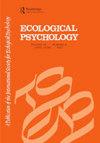Ecological Optics as the Conceptual Basis for the Interpersonal Self and Social Interaction
IF 1.7
3区 心理学
Q3 PSYCHOLOGY, EXPERIMENTAL
引用次数: 0
Abstract
Abstract Agency, the ability to negotiate one’s surroundings to bring about changes, is the defining feature of animacy. Because agency is embodied in each individual’s self, inquiry into agency is necessarily an inquiry into selfhood. William James divided selfhood into the self as “I” and the self as “me” with the I self being, in essence, an active agent responsible for thoughts and actions. In Gibson’s ecological paradigm, self plays a central role, being co-perceived with the environment. Neisser (1988), an advocate of Gibson, classified self via 5 different forms of self–knowledge, each portraying a different aspect of self. Of these, the ecological self is an agent that regulates its encounters with the surroundings based on affordances the environment offers, whereas the interpersonal self is an agent that interacts with conspecifics based on the mutual affordances their interactions offer. For interpersonal selves to interact effectively with each other necessitates that their shared environment becomes common knowledge to all participants, based on information determined in accordance with the principle of ecological optics (in particular, information about occluding edges, reversible occlusion, and opaque and non-opaque substances). We suggest that Gibson’s principles of ecological optics be extended to the social domain, as he envisioned.生态光学:人际自我与社会互动的概念基础
能动性,即通过与周围环境谈判而带来变化的能力,是生命的决定性特征。因为能动性体现在每个个体的自我中,对能动性的探究必然是对自我的探究。威廉·詹姆斯将自我分为作为“我”的自我和作为“我”的自我,其中“我”本质上是一个负责思想和行为的积极主体。在吉布森的生态范式中,自我扮演着中心角色,与环境共同感知。Neisser(1988)是Gibson的倡导者,他将自我分为五种不同形式的自我认识,每一种形式都描绘了自我的不同方面。其中,生态自我是一个基于环境提供的能力来调节其与周围环境相遇的主体,而人际自我是一个基于相互作用提供的能力与同种个体相互作用的主体。为了使人际自我有效地相互作用,必须使其共享的环境成为所有参与者的共同知识,这是基于根据生态光学原理确定的信息(特别是关于遮挡边缘、可逆遮挡以及不透明和非不透明物质的信息)。我们建议将吉布森的生态光学原理扩展到社会领域,正如他所设想的那样。
本文章由计算机程序翻译,如有差异,请以英文原文为准。
求助全文
约1分钟内获得全文
求助全文
来源期刊

Ecological Psychology
PSYCHOLOGY, EXPERIMENTAL-
CiteScore
3.30
自引率
10.50%
发文量
8
期刊介绍:
This unique journal publishes original articles that contribute to the understanding of psychological and behavioral processes as they occur within the ecological constraints of animal-environment systems. It focuses on problems of perception, action, cognition, communication, learning, development, and evolution in all species, to the extent that those problems derive from a consideration of whole animal-environment systems, rather than animals or their environments in isolation from each other. Significant contributions may come from such diverse fields as human experimental psychology, developmental/social psychology, animal behavior, human factors, fine arts, communication, computer science, philosophy, physical education and therapy, speech and hearing, and vision research.
 求助内容:
求助内容: 应助结果提醒方式:
应助结果提醒方式:


